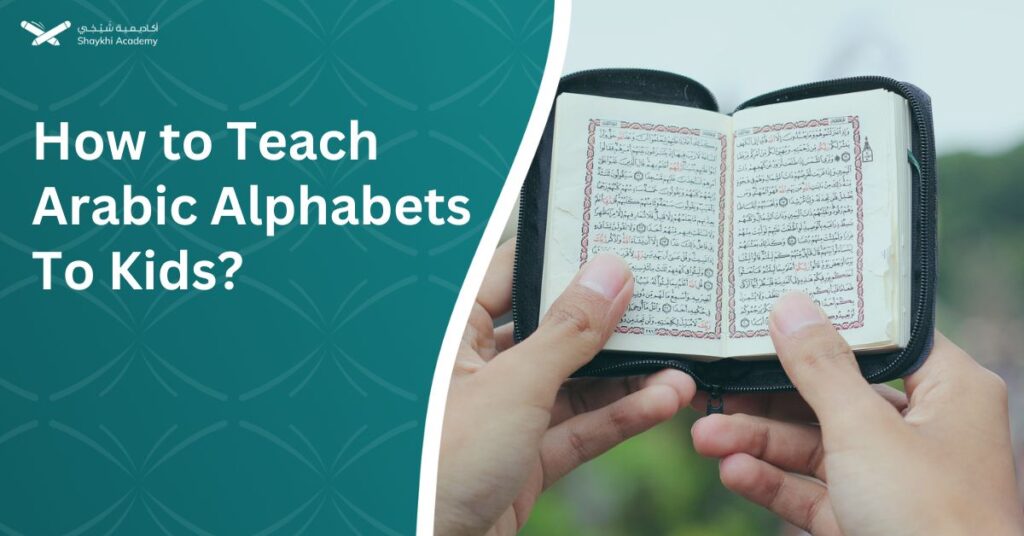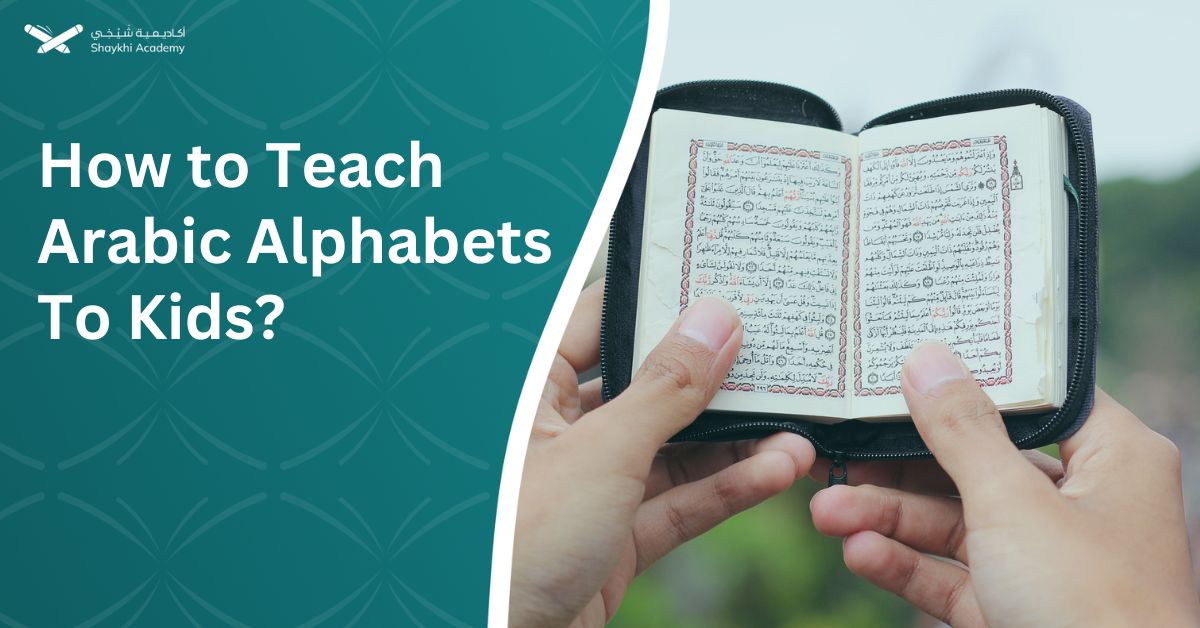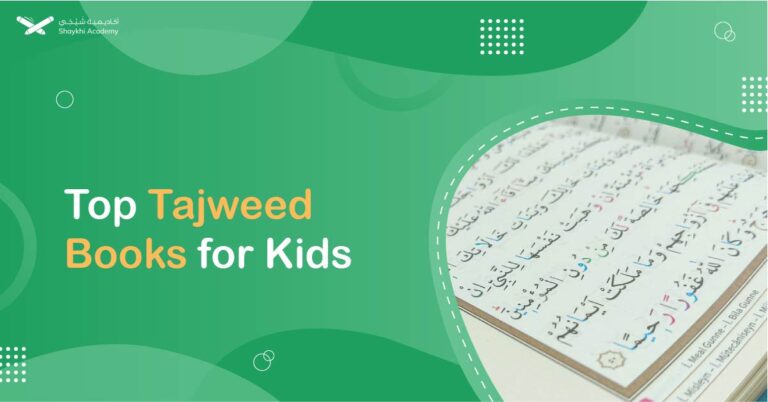In this blog post, we will discuss the significance of teaching the Arabic alphabet to kids and offer useful advice on how to teach them effectively at home. Early exposure to the Arabic alphabet can yield various advantages, such as enhancing cognitive abilities and promoting cultural awareness.

These strategies, suitable for parents and educators, aim to make the learning process enjoyable and captivating for young learners. Let us now delve into the techniques that will enable your children to explore and comprehend the world of Arabic letters.
Teach Arabic Alphabets of Kids:
Teaching the Arabic alphabet to kids involves introducing them to the individual letters of the Arabic alphabet, along with their shapes, sounds, and basic meanings. The goal is to help children recognize, pronounce, and write each letter accurately.
By teaching the Arabic alphabet to kids, they develop essential language skills and lay the foundation for reading, writing, and communicating in Arabic. Additionally, introducing the meanings associated with each letter can spark curiosity and interest in the language, making the learning process more engaging and meaningful for young learners. Overall, teaching the Arabic alphabet to kids is a vital step in their language development and cultural understanding.
Also learn more about Arabic Alphabet Book: Printable, Online, and English Version.
Importance of Teaching Arabic Alphabet for Kids
Teaching the Arabic alphabet to children is of great importance, especially for Muslims, as it is the language of the Holy Quran. We will examine the main reasons why teaching the Arabic alphabet to young children is essential.
1. Cognitive Development in Kids
Learning Arabic alphabets helps children improve their memory skills as they need to remember the shape and sound of each letter. It also enhances their analytical thinking and problem-solving abilities as they decode words and sentences.
2. Language Skills for Kids
By mastering Arabic alphabets, kids develop strong phonemic awareness which is crucial for reading and writing proficiency. They acquire better pronunciation skills by familiarizing themselves with unique sounds present in the Arabic language.
3. Connecting Kids with the Quran
For Muslims, the Quran is the holy book and the foundation of their faith. It is written in Arabic, and learning the Arabic alphabet is crucial for understanding the text directly. Teaching kids the Arabic alphabet lays the groundwork for their future Quranic studies.
4. Cultural Understanding for Kids
Teaching the Arabic alphabet provides children with a deeper understanding of Arab culture, traditions, and values from an early age. It fosters respect for diverse cultures and promotes tolerance among young learners.
5. Effective Communication for Kids:
Arabic is spoken by millions worldwide, and learning the alphabet equips children with the ability to communicate effectively with Arabic-speaking communities, fostering cross-cultural understanding and inclusivity.
Don’t miss out on this invaluable resource! Get your hands on the Al-Menhaj Book today and empower your child to embrace the wonders of the Arabic alphabet. Together, let’s pave the way for a lifetime of linguistic exploration and appreciation.
How to Teach Arabic Alphabets to Kids?
Teaching the Arabic alphabet to kids can be made fun and engaging by using a variety of techniques. Here are some effective methods:
1. Hands-on activities
Kids learn best when they can interact with tangible objects. Print out Arabic letters on construction paper and cut them individually. Allow children to hold and touch these letters while learning their names and sounds.
2. Arabic alphabet worksheets
Use worksheets that provide lines for children to practice writing Arabic letters. Start with simple exercises where kids trace over the letters and gradually move to writing them independently. This helps develop their letter formation skills.
3. Sand tray for letter formation
Provide a shallow tray filled with sand or kinetic sand. Encourage children to use their fingers or a stick to trace Arabic letters in the sand. This hands-on activity helps reinforce letter shapes and improves muscle memory.
4. Multimedia resources
Utilize videos or online resources designed specifically for teaching the Arabic alphabet to children. These resources often use animated characters and catchy tunes to make learning enjoyable and memorable.
5. Flashcards and memory games
Create flashcards with Arabic letters and corresponding images. Play memory games where children match the letters with their respective images. This activity enhances letter recognition and vocabulary building.
6. Storytelling
Incorporate storytelling into Arabic alphabet lessons. Create simple stories or rhymes that highlight the letters’ sounds and names. This interactive approach engages children’s imagination and helps them remember the letters more effectively.
7. Letter crafts
Engage kids in creative activities such as letter crafts. Provide materials like colored paper, glue, and markers for children to make crafts representing each Arabic letter. This artistic approach adds a fun element to the learning process.
8. Repetition and practice
Consistent practice is crucial in teaching the Arabic alphabet. Allocate regular time slots for practicing the letters and reinforce their recognition through games, quizzes, or writing exercises.
9. Use mnemonic devices
Mnemonic devices can aid in remembering the sounds and shapes of Arabic letters. For example, associating the shape of the letter “ba” with a boat or the sound “ta” with a ticking clock can help children remember these letters more easily.
10. Make it relevant
Connect the Arabic alphabet to everyday objects or words familiar to children. For example, associate the letter “ba” with the word “banana” or the letter “dal” with the word “door.” This connection to their daily life makes learning more meaningful for kids.
11. Positive reinforcement
Encourage and praise children’s progress throughout the learning journey. Positive reinforcement motivates them to continue learning and boosts their confidence.
12. Practice writing words
Once children have a good grasp of the Arabic alphabet, introduce simple words for them to practice writing. Start with basic vocabulary and gradually increase the complexity of the words as their skills improve.
Want a qualified online Quran Arabic teacher? Look no further! Our experienced tutors at Shaykhi Academy are dedicated to helping you learn the language of the Quran with ease.
How to Teach Arabic Alphabets of Kids at Home?
Teaching the Arabic alphabet to kids at home can be an enriching experience for both parents and children. By introducing them to the beauty of the Arabic language, you are providing them with a strong foundation for their future learning. Here are some effective ways to teach the Arabic alphabet to kids at home:
1. Start with the basics
Begin by introducing your child to the Arabic alphabet and explaining that it consists of 28 letters. Show them the letters and their shapes, emphasizing their uniqueness compared to the English alphabet.
2. Use visual aids
Visual aids such as flashcards, posters, or charts can be a great tool for teaching the Arabic alphabet. Display them in a visible area at home, like the living room or your child’s bedroom, where they can easily see and interact with the letters.
3. Sing the alphabet song
Just like in English, singing the Arabic alphabet song can help children memorize the order of the letters. Look for Arabic alphabet songs online or create your tune to make it more enjoyable for your child.
4. Practice letter formation
Encourage your child to practice writing each letter using pencil and paper. You can provide them with worksheets specifically designed for Arabic alphabets or create your tracing sheets. Make sure to teach them the correct stroke order and direction for each letter.
5. Engage in hands-on activities
Making and learning activities are effective methods for teaching the Arabic alphabet. For instance, you can use playdough to shape the letters or use a sand tray for letter formation. These tactile experiences can help reinforce the recognition and formation of the letters.
6. Play educational games
Incorporate games into your teaching approach. This can include matching games, puzzles, or memory games where your child matches Arabic letters with their corresponding sounds or objects. Utilize online resources or create your game boards to make the learning process more interactive.
7. Read and tell stories
Reading Arabic books or telling stories with Arabic alphabets can be an enjoyable way to introduce the letters. Look for children’s books that focus on the Arabic alphabet, and read them together with your child. Pause and ask questions to ensure their understanding.
8. Create a language-rich environment
Surround your child with Arabic letters and words at home. Label objects around the house in Arabic, such as their toys, books, or even furniture. This constant exposure to the language will help familiarize your child with the Arabic alphabet.
9. Use technology
There are numerous educational apps, websites, and videos available that can aid in teaching the Arabic alphabet. Look for interactive apps or online resources that incorporate games, songs, and visual aids to engage your child in learning.
10. Be consistent and patient
Learning a new language takes time, so be patient with your child’s progress. Set aside regular time for practicing the Arabic alphabet and make sure to be consistent with your teaching methods. Encourage and praise your child’s efforts to boost their motivation.
Give your child a strong foundation in Arabic with Shaykhi Academy’s Noorani Qaida for Kids program. Start learning today and watch your child flourish in their language skills!
Best Age to Start Teaching Arabic Alphabets to Kids
The best age to start teaching the Arabic alphabet to kids is generally between the ages of 3 and 5. Children have now developed fundamental motor skills and cognitive abilities to learn letters and sounds and recognize visual patterns.
It is important to make the learning experience interactive and engaging, using visual aids and games to capture their attention and facilitate their understanding of the unique Arabic script. However, every child is different, so assessing their readiness and adapting the teaching approach is crucial.
Read an indepth discussion on How Long Does It Take To Learn Arabic?
Nurture Your Child’s Linguistic Skills: Sign Up for Online Arabic Classes for Kids at Shaykhi Academy Today!
At Shaykhi Academy, kids can participate in online Arabic classes for kids that cater to beginners and focus on various aspects of the language. The academy ensures that qualified teachers deliver these classes to provide the best learning experience for both kids and their families.
Additionally, the Al-Menhaj Book is used as a source to enhance the curriculum and provide valuable resources for learning Arabic effectively. Through these online classes, children can acquire skills in the Arabic alphabet, and Quranic Arabic, and engage in interesting conversations to develop their language proficiency.
Conclusion
Teaching the Arabic alphabet to kids is crucial for language development. This article offers practical methods for effective teaching at school and home. Adapt your approach based on each child’s needs and preferences.
Online Arabic classes for kids at Shaykhi Academy and resources like the Al-Menhaj Book can make learning fun and engaging. With practice and support, children can confidently master the Arabic alphabet and embark on a language acquisition journey.




















